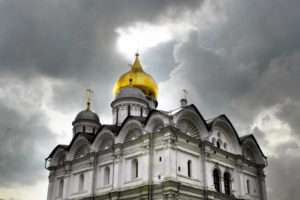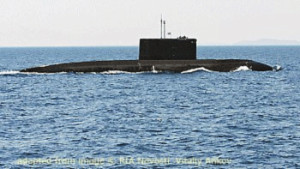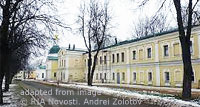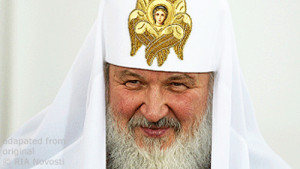How Much Did Orthodox Church Help Revive Russia’s Military and Nuclear Complex? [Book Review of “Russian Nuclear Orthodoxy: Religion, Politics and Strategy”]

(Russia Matters – russiamatters.org – Dmitry Gorenburg – April 23, 2019 – russiamatters.org/analysis/how-much-did-orthodox-church-help-revive-russias-military-and-nuclear-complex)
Dmitry Gorenburg is a senior research scientist at CNA.
BOOK REVIEW
“Russian Nuclear Orthodoxy: Religion, Politics and Strategy”
By Dmitry Adamsky
Stanford University Press, April 2019
“Russian Nuclear Orthodoxy,” an important new book by the Israeli scholar Dmitry Adamsky, explores the critical but highly understudied juncture between religion and the military. Focusing on the role played by the Russian Orthodox Church (ROC) in the restoration and development of the Russian nuclear weapons complex in the post-Cold War period, Adamsky highlights the organizational and ideological impact of the church on the gradual remilitarization of Russia over the last three decades. Adamsky has written a highly readable and informative book on a woefully understudied topic, though one that at times reads like a continuous success story for the church and raises many questions. Also, the book would have been strengthened by a more comparative focus, vis-à-vis both the role of other religious faiths in Russia and the experience of other countries.
 The main argument comes in three parts. First, the church has played and will continue to play a crucial role in promoting the rebuilding of the Russian military in general and the nuclear weapons complex in particular. The book demonstrates that the church was among the earliest advocates for the nuclear weapons complex, at a time when the military and nuclear agencies were generally unpopular among Russians and neglected by a cash-strapped government. Second, the church has influenced the direction of security thinking among both Russian politicians and military leaders. Finally, church advocacy has resulted in a gradual conflation of national defense and rearmament with holiness and spirituality. The protection of the state and nation through armed force has been portrayed as a holy act that is highly compatible with religious belief and spiritual values.
The main argument comes in three parts. First, the church has played and will continue to play a crucial role in promoting the rebuilding of the Russian military in general and the nuclear weapons complex in particular. The book demonstrates that the church was among the earliest advocates for the nuclear weapons complex, at a time when the military and nuclear agencies were generally unpopular among Russians and neglected by a cash-strapped government. Second, the church has influenced the direction of security thinking among both Russian politicians and military leaders. Finally, church advocacy has resulted in a gradual conflation of national defense and rearmament with holiness and spirituality. The protection of the state and nation through armed force has been portrayed as a holy act that is highly compatible with religious belief and spiritual values.
The book is organized chronologically by decade. The first, labeled the Genesis Decade, follows the collapse of the Soviet Union and is the period during which the church-nuclear nexus was first developed, beginning as a grassroots phenomenon within the nuclear complex that combined with outreach efforts by the ROC. The second decade, labeled the Conversion Decade, features the emergence of a top-down trend that supplemented the bottom-up initiatives of the 1990s. During this period, which coincides with Vladimir Putin’s first 10 years in power, the increased role of religion in Russian society and political life merged with a gradual increase in societal respect for the Russian military to result in the formulation of the “nuclear orthodoxy doctrine.” The Operationalization Decade of the last 10 years, Adamsky argues, has resulted in peak clericalization of the Russian military and Russian foreign policy. During this period, “Orthodoxy became the main pillar of Russian nationalism and the basis of state ideology”; in the military sphere, “religious rituals became tightly interwoven with … combat activities” while “priests have penetrated all levels of command.”
Each decade is divided into three thematic chapters, with the first describing church-state relations during the decade in question and the second focusing on the steps taken to increase the penetration of the church into the military in general and specific branches in particular. The third chapter examines religion-oriented strategic mythmaking during that decade and its impact on national security discourse.
Several key themes permeate the book, including the role of priests who had previously served in the military as key conduits for the development of connections between the ROC and the military. These priests not only conduct services and provide religious guidance on base, but deploy on nuclear submarines, bless spacecraft and generally participate in every aspect of military life.

It also turns out to have been vitally important that, during the Soviet period, several key nuclear facilities were established on the territory of monasteries that had been confiscated from the ROC. The location of these facilities on holy land has been used to justify the sacred role of Russian nuclear forces in protecting the motherland. The irony of nuclear facilities built on confiscated church land then being used as justification for the holy purpose of Russia’s nuclear forces is not lost on the reader. The deepening of church-state relations during the period under study can be charted through the development of the long-term and ultimately successful campaign to introduce chaplains into the Russian military. These chaplains have now taken up some of the roles fulfilled by military political officers during the Communist period, and have also gone beyond them in some ways. Since the establishment of the military chaplain program, priests are directly involved in work on maintaining morale among soldiers and ensuring their reliability during combat. They also consecrate new weapons and platforms, not only blessing newly commissioned nuclear submarines and long range bombers, but even performing such acts on new nuclear missiles.
To its great credit, the study goes well beyond the organizational aspects of the “churchification” of the Russian military. Adamsky asks important questions regarding the tension between the generally peace-loving nature of Christianity and the glorification of the military that is found in the 21st century conception of Russian nuclear orthodoxy. He highlights the role that religious belief may play in increasing the likelihood that missile officers would follow orders to launch nuclear missiles, concurrently explaining why in the Russian environment religious belief does not create doubts about the morality of such orders. And he discusses the role that the ROC has played in developing some of the dominant aspects of Russian foreign policy, including the use of the “Russian World” concept to connect to Russian-speaking populations in other countries and the emphasis on promoting traditional values. In that context, I would have liked to see more evidence for the author’s argument that the religious motivation for Russian foreign policy is authentic, and not just a narrative justification being promoted for public consumption.
No book, no matter how thorough, can cover every aspect of this subject. Reading “Russian Nuclear Orthodoxy” left me with a number of questions about the role of the ROC in reviving the Russian armed forces and about the relationship between religion and the Russian military more generally. In relation to the church’s role in reviving the Russian military, I was left wondering whether there was anything particular about Patriarch Alexy II (1990-2008) and his successor  Patriarch Kirill that led them to spearhead the ROC’s engagement with the military in the immediate aftermath of the collapse of Communism. Was there something in their backgrounds that connected them to the military or made them think that this was a plausible avenue for cooperation? Or was their leadership just the consequence of their circumstances and positions? More generally, how did the ROC go about lobbying for the nuclear complex? Were relations between the ROC and the military and nuclear complex always as frictionless as the author portrays them, or were there conflicts and setbacks along the road to the current cooperative arrangement? Why were the ROC’s appeals more effective than those of other groups that supported the military? I would have liked to see more detailed evidence that the change in popular and political support for the military came from the activities of the ROC, rather than just from changes in the political environment or in leaders’ security perceptions. While the book presents some statements by people from the military and especially from the nuclear complex testifying to the role of the ROC, the argument would have been strengthened by the presentation of statements of impact by government officials or through evidence of specific actions by the ROC that resulted in improvements in the situation of the military.
Patriarch Kirill that led them to spearhead the ROC’s engagement with the military in the immediate aftermath of the collapse of Communism. Was there something in their backgrounds that connected them to the military or made them think that this was a plausible avenue for cooperation? Or was their leadership just the consequence of their circumstances and positions? More generally, how did the ROC go about lobbying for the nuclear complex? Were relations between the ROC and the military and nuclear complex always as frictionless as the author portrays them, or were there conflicts and setbacks along the road to the current cooperative arrangement? Why were the ROC’s appeals more effective than those of other groups that supported the military? I would have liked to see more detailed evidence that the change in popular and political support for the military came from the activities of the ROC, rather than just from changes in the political environment or in leaders’ security perceptions. While the book presents some statements by people from the military and especially from the nuclear complex testifying to the role of the ROC, the argument would have been strengthened by the presentation of statements of impact by government officials or through evidence of specific actions by the ROC that resulted in improvements in the situation of the military.
A second set of questions relates to how the ROC’s activism in supporting the military and the nuclear complex relates to the church’s overall outreach strategy. I would have liked to see more comparison made between the churchification of the nuclear branches of the military and other (non-nuclear) branches, as well as a more systematic discussion of when the military takes the lead on cooperation with the ROC and vice versa. Furthermore, the approach of examining ROC outreach sector by sector prevents the author from discussing how the outreach to the military relates to the outreach to the nuclear complex. I would have liked to see a more comparative discussion in general, addressing for example whether other security services such as the FSB are similarly taken by Orthodoxy. In other words, the book leaves open the question of how unique ROC penetration of the military is when compared to other Russian institutions.
Finally, the book does not mention the role of Russia’s three other “official” faiths—Judaism, Islam and Buddhism. Reliable data on the religious composition of the Russian population is relatively hard to come by, and data on the religious composition of the Russian military may not exist in the public domain. One source, based mostly on a large-scale 2012 survey, indicates that just over 42.5 percent of Russians consider themselves Orthodox, while 6.5 percent identify as Muslim, 0.5 percent as Buddhist and less than 0.5 percent as Jewish; outside the four official faiths, approximately 5 percent consider themselves Christian but not Orthodox, 25 percent say they believe in God but aren’t affiliated with a particular religion and 13 percent identify as atheists. Another source, by contrast, shows that in 2008 72 percent of Russian adults identified as Orthodox Christian, while only 18 percent considered themselves religiously unaffiliated or non-believers, with the remaining 10 percent being distributed among other religious traditions. This discrepancy highlights the difficulty in providing reliable data on religious affiliation.
The government’s rules for military chaplains indicate that representatives from all four official faiths may serve as such, but allow no role for representatives of other faiths, including Christian denominations such as Catholicism or Protestantism. We know that a small number of Buddhist and Muslim chaplains were hired in the early years of the program. But it is not clear how the three non-Christian official faiths’ role in the military or nuclear sector compares with that of the ROC. How many chaplains from these faiths are currently working in the military? How do they relate to the ROC involvement in the military? What happens to members of other faiths who serve in the military or work in the nuclear complex? Do they face discrimination or exclusion from senior positions by virtue of not being connected to the ROC?
“Russian Nuclear Orthodoxy” highlights an aspect of the development of the post-Soviet Russian military that has gone virtually unmentioned in existing studies. Future work on the role of the military in Russian society and in Russian foreign policy will have to take into account the extent to which it has been shaped by its alliance with the Russian Orthodox Church. At the same time, scholars of religion will need to consider more fully the questions of how and why the church entered into an alliance with the military and what this alliance means for religious life in Russia going forward, especially the possibility of the existence of contrasting currents of thought within the ROC. In particular, it would be interesting to highlight the valorization of the military by thinkers within the ROC with ideas related to just war theory and nuclear disarmament as developed by doctrinal thinkers within the Catholic Church. Adamsky has thus written an important work that opens new landscapes for scholarship.
[featured images are file photos]
Kindle:
Paperback:
Hardcover:
Article also appeared at russiamatters.org/analysis/how-much-did-orthodox-church-help-revive-russias-military-and-nuclear-complex, with different images and absent the ads, bearing the notice: “© Russia Matters 2018 … This project has been made possible with support from Carnegie Corporation of New York,” with a footer heading entitled “Republication Guidelines” linking to: russiamatters.org/node/7406, which bears the notice, in part:
“If you would like to reprint one of these articles, a blog post written by RM staff, one of our infographics or a fact-check, we ask that you follow these guidelines:
- Include a prominent attribution to Russia Matters as the source and link back to the original at RussiaMatters.org.
- Retain the hyperlinks used in the original content.
- Do not change the meaning of the article in any way.
- Get an ok from us for non-substantive changes like partial reprints or headline rewrites and inform readers of any such modifications (e.g., This article first appeared on the Russia Matters website with the headline “Russian Election Interference in Trump’s Own Words”).
- Let us know about the reprint and send a link!
Please note that Russia Matters cannot grant permissions for third-party content, including articles, photographs and other materials not produced by our team.
Questions? Email us at RussiaMatters@hks.harvard.edu.”
